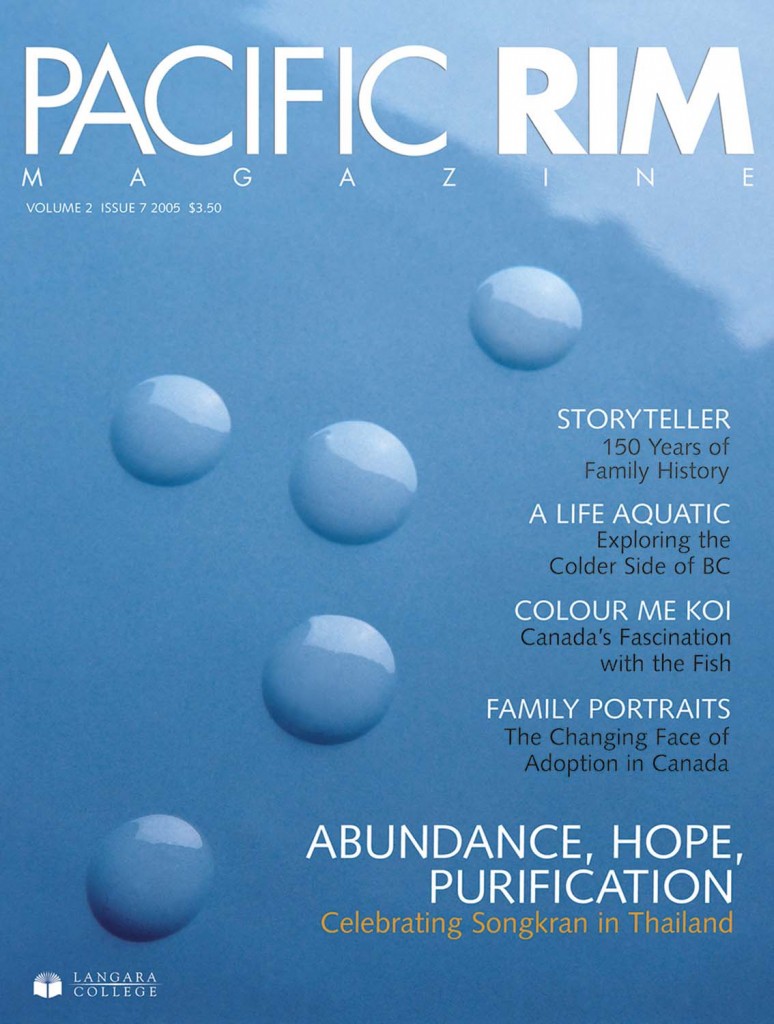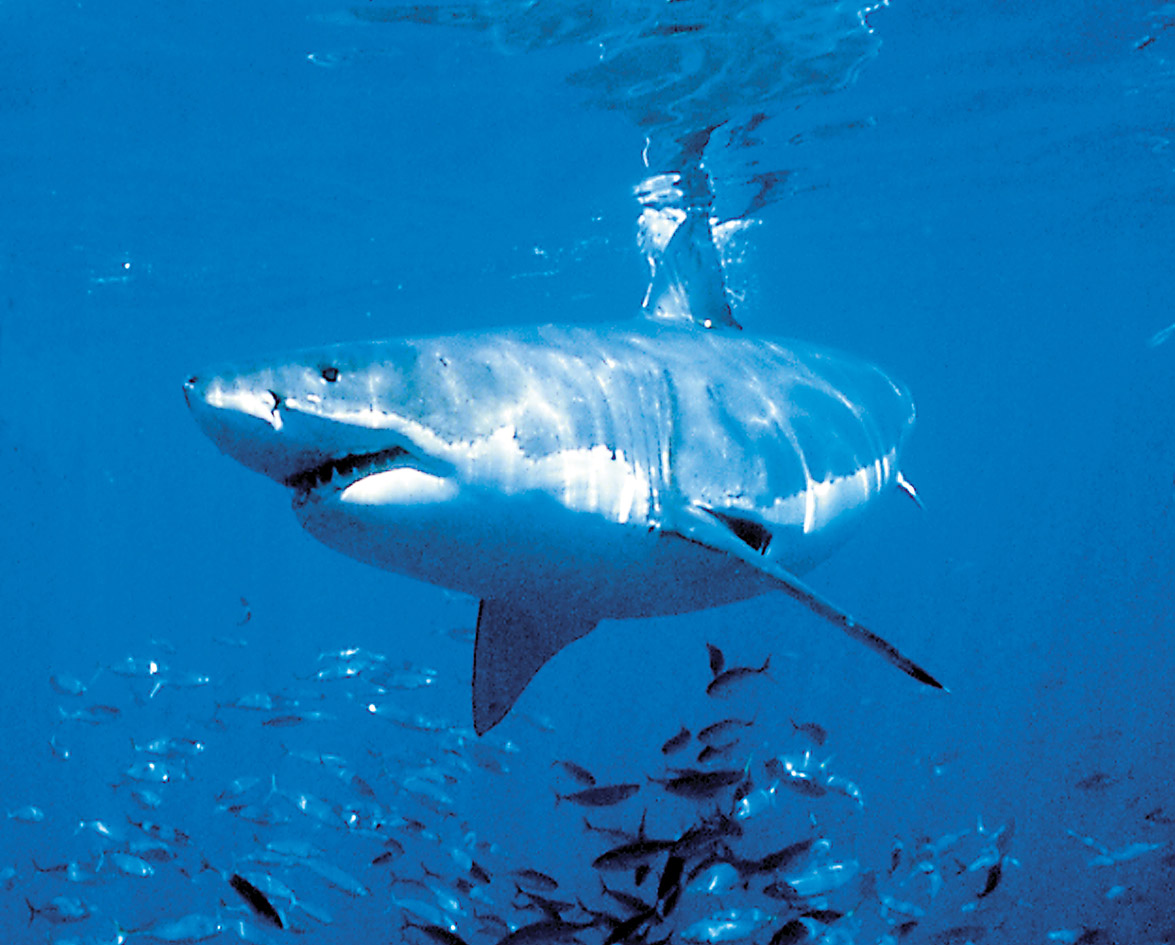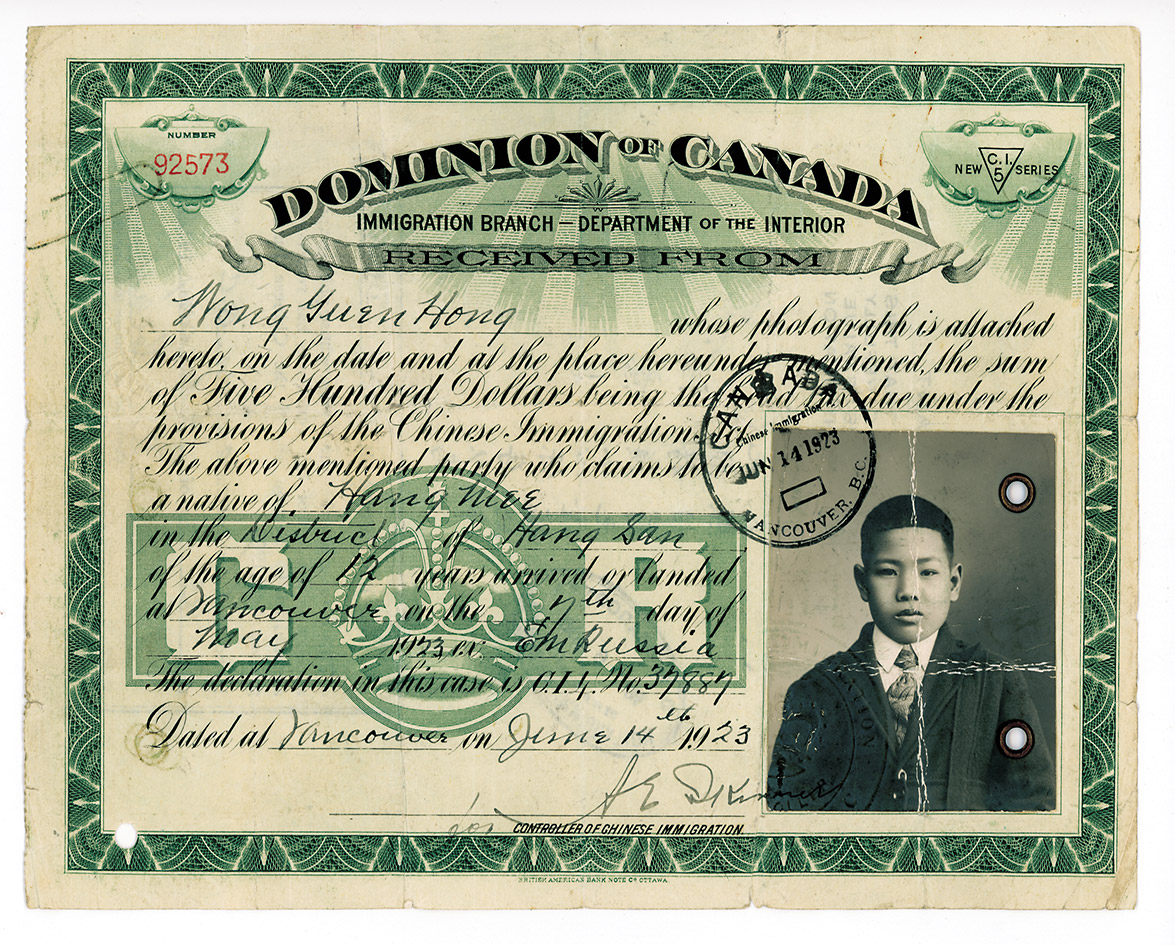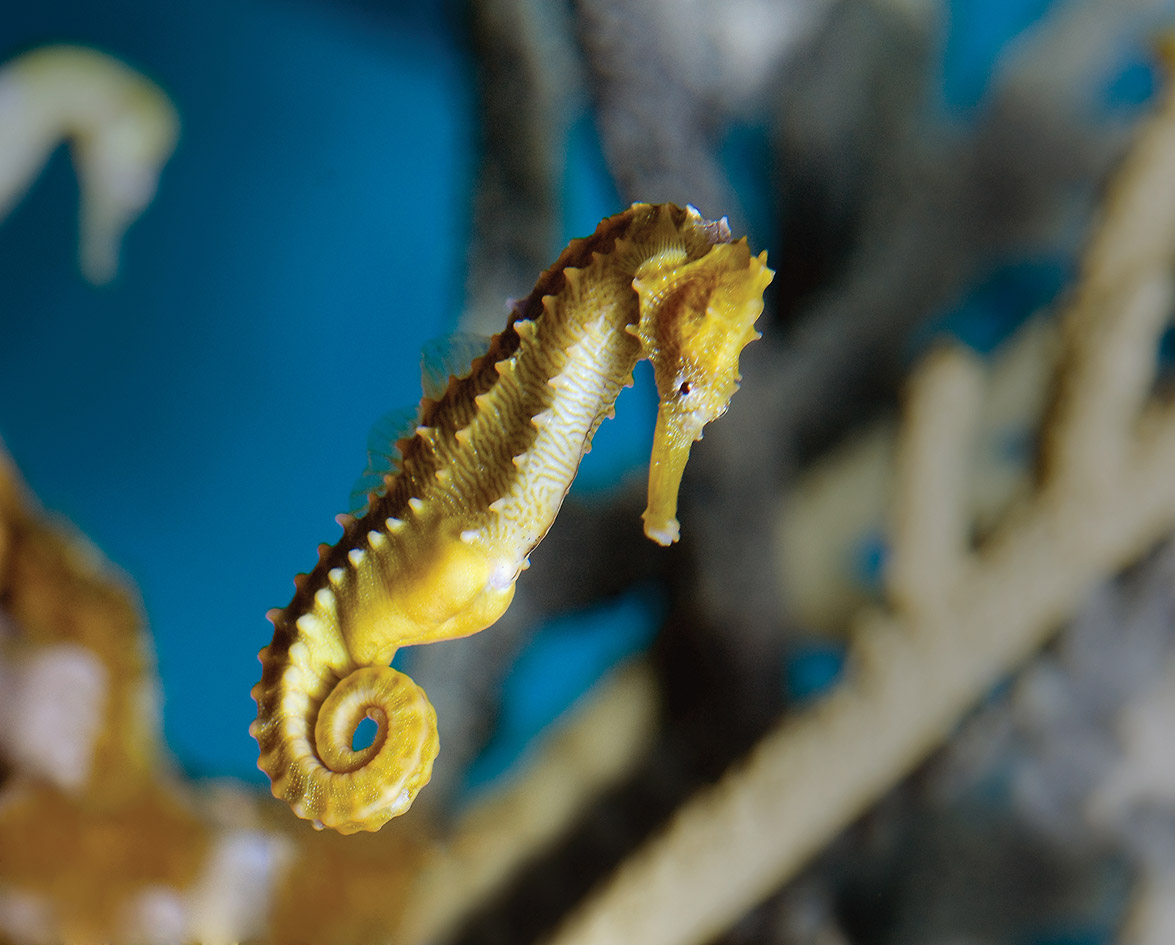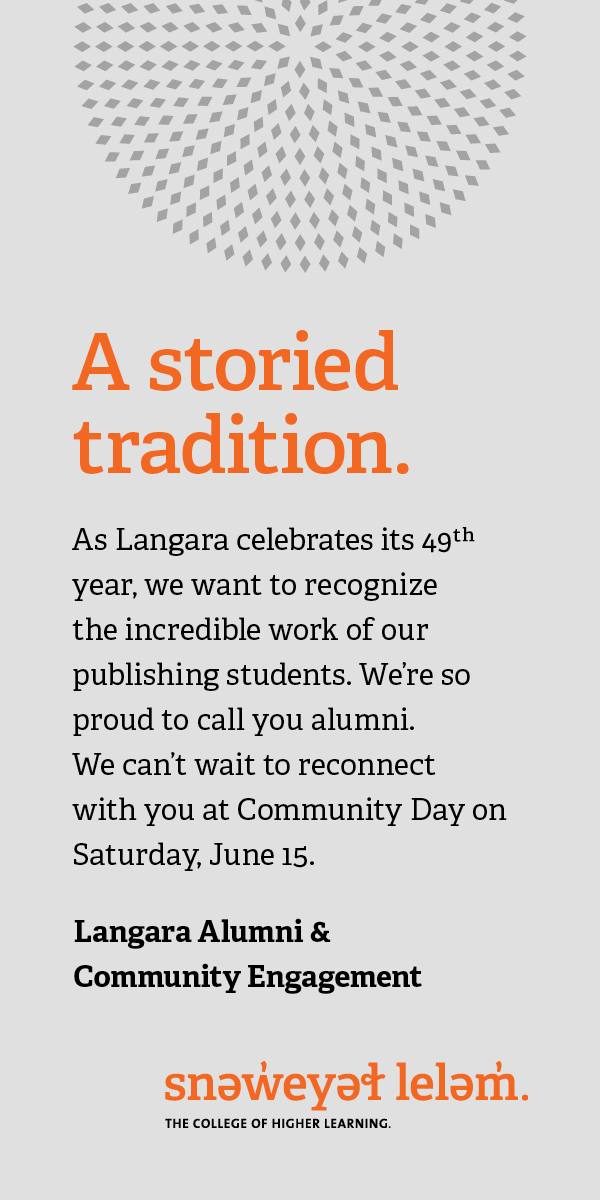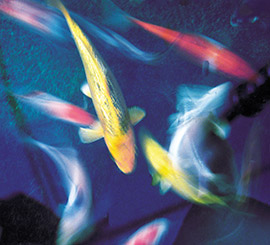
Gazing into the pristine pool, you are greeted by elegant swirls of white, peppered with splashes of orange, black, and red. Otherworldly creatures with cat-like whiskers propel themselves through the dreamy liquid with graceful butterfly wings. Their watery paradise is densely populated, yet no tension exists between them; each one gently nudges the other as it glides past. A speckled map of colour retires from its laps and rests on the pool’s sandy bottom. A mate interrupts the placid being’s doze and challenges it to a playful game of tag. Politely declining, it burrows itself deeper into the cool sand. Unphased by the rejection, the more gregarious fish darts wildly around the pool, finally jutting its head out of the water, smacking its lips and sniffing the clean, humid air.
Koi have fascinated the Western world since the 1950s. Although relatively new to our culture, this strikingly beautiful fish has been adored in Asia for centuries. With more and more koi ponds appearing throughout British Columbia’s Lower Mainland, you may wonder where these majestic fish have come from, why we have so readily embraced them, and what care they require.
The History Of Koi Fish
The history of Koi fish has been an exercise in speculation. Most experts agree, however, that the ancestor of the present-day breed originated in Persia and was eventually introduced to China and Japan. This ancestor, known as the common carp, was an incredibly hardy fish, but was lackluster in colour. These wild carp still exist today and are used for food by people in Asia.
No one knows exactly how the koi separated from its less colourful cousin, but some historians feel that the Chinese helped develop different colour variations in the fish. In fact, the first mention of carp with colours is found in a Chinese book written during the Western Chin Dynasty between 255 and 316 AD. In the book, koi are described as having different colour patterns, including black, blue, red, and white.
Eventually, the Japanese became world leaders in selective koi breeding and continue to hold that position today. Koi breeding as we know it began in Japan during the 17th century. As rice farmers noticed wild carp having offspring with unusual colour patterns, they bred those offspring over many generations to produce the koi we presently know and love. It wasn’t until the 19th and 20th centuries, however, that the koi’s status was changed from food source to pampered pet. In the early 1900s, the fish’s popularity exploded throughout Japan. The fish fervor soon hit the rest of the world, with a renewed interest in koi ponds catching on in North America over the past two decades.
Koi Fish In Vancouver
The elegant and charming koi has found a place in the hearts of Vancouverites. Housed within a huge globe-like structure, the Bloedel Conservatory in Queen Elizabeth Park is Vancouver’s premier koi watching spot. The blossom-covered koi pond, with its winding turns and soothing waterfall, is the first thing you encounter upon entering the self-contained piece of paradise. The pond houses a beautiful variety of koi, ranging in age from one to 20 years old. Some of the older koi are gigantic, measuring up to 24 inches in length. These fish are thriving, seeming more than happy to endlessly circle their heavenly surroundings.
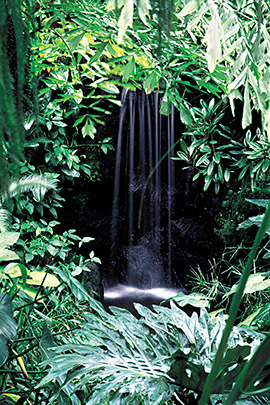
“They are appealing because of their colours, sleek form, and graceful motions in the water,” beams Alex Downie, supervisor of Queen Elizabeth Park and the Bloedel Conservatory. The conservatory’s koi, most of which are originally from Japan, draw thousands of local and international visitors per year. People are naturally attracted to the fish’s beauty and calm nature.
Bloedel’s head gardener, Mark Rabey, feels that the public connects with the koi because they are peaceful and aware of humans. As their daily caretaker, Mark has found a favourite among them, a massive orange and black male he affectionately calls “Grand-daddy.” This king-sized beast spends most of his time resting on the bottom of the pool, but is the first to surface at feeding time. “These fish have a concept of time,” says Mark. “They know when it’s time to be fed. If I’m even a few minutes late, they all gather at the side of the pool and look for me.”
Those who are truly “koi kichi” (koi crazy) devote themselves to creating an ideal environment for their companion koi.
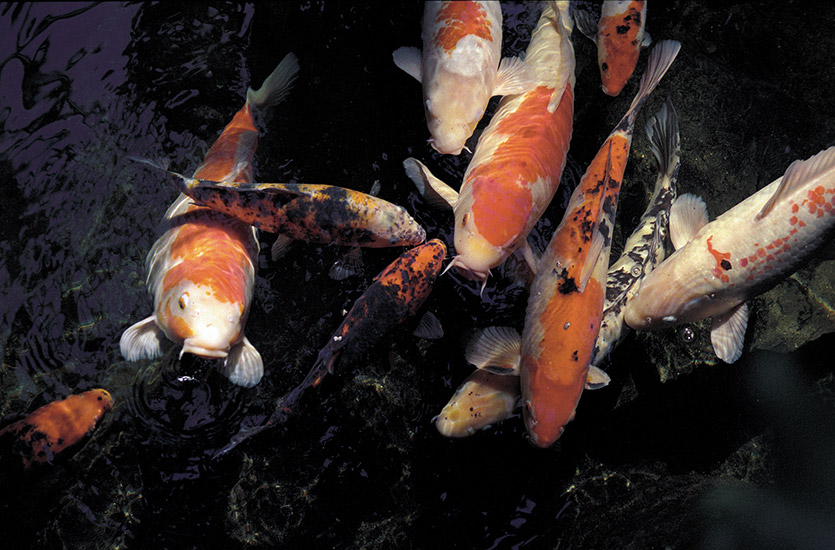
Marine biologist Dr. Herbert R. Alexrod states that “while koi are very hardy and can live under almost unbearable (for other fishes) conditions, they only thrive and show off their best colours and behaviour when they are properly managed. “Those who are truly “koi kichi” (koi crazy) devote themselves to creating an ideal environment for their companion koi. A highly adaptable fish, Koi can be kept in either an aquarium or a pond (see “Koi Pond Building Tips”). And yes, it is a myth that koi will voraciously outgrow any container they are housed in. As Roger Macpherson, president of the B.C. Koi Club of Canada and a koi keeper since 1987, puts it, “people grow to different sizes depending upon their genetics and food, not the size of their bedroom or house.” The same can be said for the plucky koi.
The Survival Of Koi
Although the koi is hardy enough to survive a winter much harsher than Vancouver’s, it still requires more care that its common carp ancestor. Selective breeding for colour and shape has robbed the koi of some of its carp stamina. Macpherson explains, “Consider koi as a race horse is to the average horse.” Koi may be more beautiful and graceful than their average cousins, but they are also more sensitive to their environment.
Most important to a Koi’s health is clean water, free from pollutants. This can be achieved with the use of a quality organic filter. The pond water at the Bloedel Conservatory is continuously filtered through two huge Jacuzzi-like sand filters which are backwashed daily to remove any contaminants. In addition, 20 per cent of the water is removed and replaced daily with new water, which is run through activated charcoal to remove chlorine and other impurities. Attendants also add salt to the water, which protects the fish from skin parasites.
Satisfying the koi’s dietary needs is not difficult. Like their human caretakers, koi are omnivorous, consuming both plant and animal matter. Although many manufactured foods are designed to meet the koi’s nutritional requirements, the feisty fish will also eat foods prepared in your own kitchen; the conservatory koi are fed green peas one day and commercially prepared Trout Chow the next.
For the aspiring keeper of the koi, Macpherson offers this advice: “Read as much information as you can on the hobby. If you decide to have a garden pond built, ask to see the work done by the company. Get addresses to visit, and speak with the pond owners.” If you crave information on the koi, you’re in luck; as the popularity of this breed has continued to grow, so has the amount of web and print resources available to you. The ambitious fish lover in you should balance passion with preparedness as you welcome these hearty little souls into your world.






